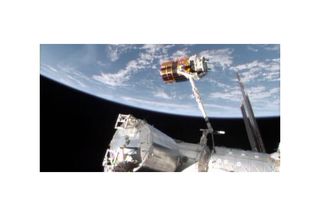
Japanese Cargo Ship Leaves Space Station

Astronauts on the International Space Station released an unmanned Japanese cargo ship from its docking port Wednesday (Sept. 4), setting the stage for the arrival of a new private delivery ship later this month.
Japan's robotic H-2 Transfer Vehicle 4 (HTV-4) left the space station at 12:20 p.m. EDT (1620 GMT) after one month linked to the orbiting lab's Earth-facing Harmony module. NASA astronaut Karen Nyberg released the disposable cargo ship back into space using the station's robotic arm. HTV-4 launched to the space station on early August to delivery 3.5 tons of supplies to the station's six-person crew. The spacecraft is slated to burn up in Earth's atmosphere during its re-entry on Sept. 7. [See photos of Japan's HTV-4 mission to space]
The departure of HTV-4 , which is also known as Kounotori-4 (Kounotori means "White Stork" in Japanese), clears the Harmony docking port for the arrival of the first Cygnus cargo ship test flight by the commercial spaceflight company Orbital Sciences Corp. Orbital has a $1.9 billion contract with NASA to provide at least eight cargo delivery missions to the space station using its Cygnus spacecraft and Antares rockets. The first Antares rocket test flight launched successfully in April. The first Cygnus module is due to launch to the space station on Sept. 17. Orbital is one of two companies with cargo delivery contracts with NASA. The California-based SpaceX has a $1.6 billion contract for 12 delivery flights using its own unmanned Dragon capsules and Falcon 9 rockets. SpaceX has launched two of those missions so far.
Email Tariq Malik at tmalik@space.com or follow him @tariqjmalik and Google+. Follow us @Spacedotcom, Facebook and Google+. Original article on SPACE.com.
Get the Space.com Newsletter
Breaking space news, the latest updates on rocket launches, skywatching events and more!
Join our Space Forums to keep talking space on the latest missions, night sky and more! And if you have a news tip, correction or comment, let us know at: community@space.com.

Tariq is the Editor-in-Chief of Space.com and joined the team in 2001, first as an intern and staff writer, and later as an editor. He covers human spaceflight, exploration and space science, as well as skywatching and entertainment. He became Space.com's Managing Editor in 2009 and Editor-in-Chief in 2019. Before joining Space.com, Tariq was a staff reporter for The Los Angeles Times covering education and city beats in La Habra, Fullerton and Huntington Beach. In October 2022, Tariq received the Harry Kolcum Award for excellence in space reporting from the National Space Club Florida Committee. He is also an Eagle Scout (yes, he has the Space Exploration merit badge) and went to Space Camp four times as a kid and a fifth time as an adult. He has journalism degrees from the University of Southern California and New York University. You can find Tariq at Space.com and as the co-host to the This Week In Space podcast with space historian Rod Pyle on the TWiT network. To see his latest project, you can follow Tariq on Twitter @tariqjmalik.
